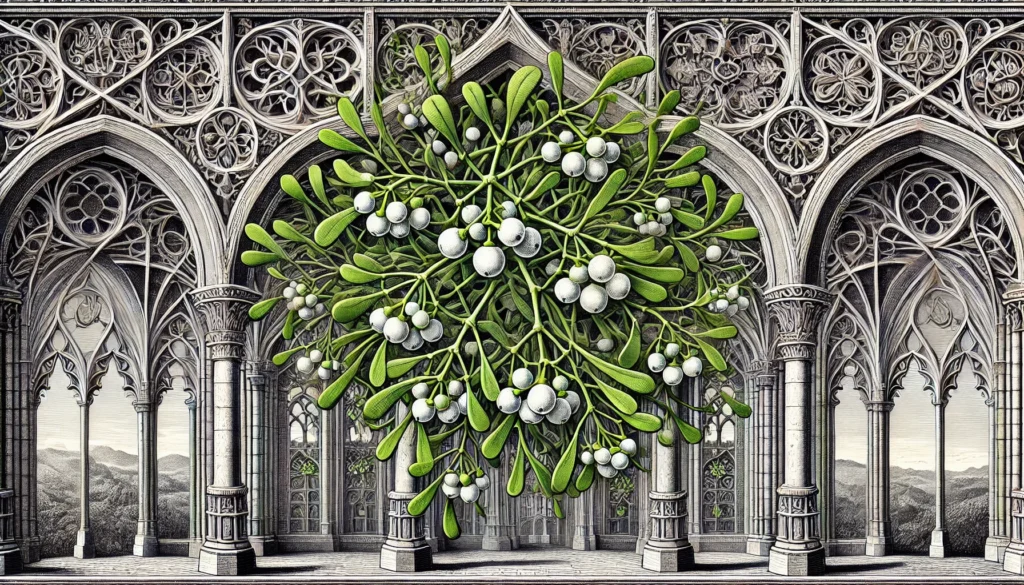

Home » Cat Plants » Is Your Cat at Risk from the American Mistletoe Plant?

The American Mistletoe (Phoradendron serotinum) is a plant that can pose a risk to cats if ingested. While not as toxic as its European counterpart, it still contains substances that can be harmful to felines. American Mistletoe is moderately toxic to cats due to the presence of toxalbumins and phoratoxins. These compounds can cause gastrointestinal upset and, in rare cases, more severe symptoms.
The plant is commonly found as a holiday decoration during the Christmas season, making it a potential hazard for curious cats in many households.
Ingestion may cause mild gastrointestinal upset, but is generally not life-threatening.
Ingestion can result in mild symptoms like vomiting, diarrhea, or drooling. Rarely fatal but may require veterinary care.
Eating these plants can lead to more pronounced symptoms like abdominal pain, lethargy, or difficulty breathing. Veterinary intervention may be necessary.
Ingesting even small amounts can cause severe symptoms like organ damage, seizures, or cardiac failure without rapid treatment.
All parts of these plants are extremely poisonous to cats and can quickly lead to death, even with immediate veterinary care.
** Please note: Please note that toxicity level can vary based on the amount ingested and the specific cat. It's always best to keep these plants completely inaccessible to cats and seek immediate veterinary care or call the poison hotline if you suspect your cat has ingested any part of a toxic plant.
If your cat ingests American Mistletoe, it’s important to be aware of potential symptoms. While many cats may not show any signs after consuming small amounts, others can experience various adverse effects.Common symptoms of American Mistletoe poisoning in cats include:
In rare cases or with larger ingestions, more severe symptoms may occur:
It’s crucial to monitor your cat closely if you suspect they’ve eaten any part of the mistletoe plant and contact your veterinarian immediately if you notice any of these symptoms.
If you bring your cat to the veterinarian due to suspected American Mistletoe ingestion, they may follow these steps for diagnosis:

A: The American Mistletoe (Phoradendron leucarpum) is considered toxic to cats. It contains toxins that can lead to symptoms such as vomiting, diarrhea, low blood pressure, and difficulty breathing if ingested.
A: If your cat eats American Mistletoe, it may exhibit symptoms like vomiting, diarrhea, a drop in blood pressure, excessive drooling, and respiratory issues. Immediate veterinary attention is advised.
A: Even small amounts of American Mistletoe can be dangerous for cats. The berries, leaves, and stems all contain toxins, so it’s important to keep this plant away from your pets.
A: If your cat ingests American Mistletoe, contact a veterinarian right away. The vet may recommend inducing vomiting or providing other treatments to reduce the absorption of the plant’s toxins.
A: Yes, both American Mistletoe and European Mistletoe are toxic to cats. They contain different compounds, but both pose significant health risks if consumed by your cat.
A: To keep your cat safe, avoid using Mistletoe as decoration during the holidays or keep it in areas your cat cannot reach. Consider using cat-safe alternatives like artificial plants instead.
This is ready for you to copy and paste! Let me know if you need any other changes.
American mistletoe (Phoradendron leucarpum), native to North America, has been used medicinally for centuries. Indigenous peoples utilized it for various ailments. During the 1800s, it gained popularity as a Christmas decoration, becoming a symbol of holiday cheer and romance.
Today, American mistletoe remains a beloved holiday tradition. While its medicinal use has declined due to toxicity concerns, it plays a crucial ecological role, providing food and habitat for wildlife. Conservation efforts aim to protect this plant, balancing its cultural significance with its importance in forest ecosystems.
ASPCA Animal Poison Control - ASPCA Pet Poison Helpline: Mistletoe - Pet Poison Helpline American Mistletoe Poisoning in Cats - Wag! Is mistletoe poisonous? - Poison Control Mistletoe Poisoning: What to Know - WebMD
Please note: The information shared in this post is for informational purposes only and should not be considered as veterinary medical advice.
🐾 A hilarious or heart-melting cat video
🐾 Our latest paws-on review of a cool cat toy